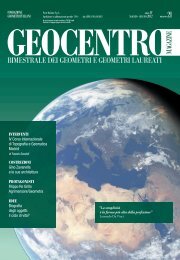Geocentro Magazine - Fondazione Geometri
Geocentro Magazine - Fondazione Geometri
Geocentro Magazine - Fondazione Geometri
You also want an ePaper? Increase the reach of your titles
YUMPU automatically turns print PDFs into web optimized ePapers that Google loves.
56<br />
ANNO II | n. 7 | GENNAIO - FEBBRAIO 2010<br />
Autoritratto, Raff aello<br />
Self-portrait, Raphael<br />
fornendo al rilevatore gli elementi sufficienti per la<br />
restituzione grafica di un poligono di n lati, rappresentante<br />
il perimetro esterno dell’edificio o il circuito murario di una<br />
città nel rapporto di scala prescelto.<br />
Gran parte del Cinquecento è ancora dominata da una<br />
continua ricerca tesa al perfezionamento delle tecniche<br />
di rilevamento ed alla progettazione di nuovi strumenti<br />
topografici.<br />
La ricca strumentaria del settore, sia di nuova invenzione,<br />
sia recuperata dalla tradizione medievale, si compone di<br />
varie suppellettili scientifiche come l’astrolabio, il bastone<br />
di Giacobbe, l’archipendolo, l’odometro, il quadrante,<br />
l’ottante, il quadrato geometrico, la bussola topografica, il<br />
radio latino.<br />
I più illustri topografi rinascimentali fanno regolare uso<br />
di goniometri e di bussole topografiche, con divisioni<br />
differenti, dalle 48 parti del goniometro albertiano, alle<br />
32 divisioni della bussola di Raffaello, alle 160 di Antonio<br />
da Sangallo il Giovane, fino alla definitiva affermazione<br />
della circonferenza di 360 parti, composta da 8 settori,<br />
corrispondenti ai rispettivi vertici della Rosa dei venti<br />
centrata su Malta (Tramontana, Grecale, Levante, Scirocco,<br />
Ostro, Libeccio, Ponente e Maestrale), suddivisi a loro volta<br />
in 45 parti ciascuno.<br />
the perimeter of a building or the surrounding walls of a town,<br />
using a scale of choice.<br />
Most of the XVI century was spent on searching for an<br />
improvement of survey techniques and for the designing of<br />
better topographical instruments.<br />
Newly invented or taken from the Middle Age tradition, the<br />
rich set of instruments used in this field includes the astrolabe,<br />
the Jacob’s staff, the archipendulun, the odometer, the quadrant,<br />
the octant, the geometrical dial, the topographical compass, the<br />
Latin radio.<br />
The most famous Renaissance topographer made a constant use<br />
of goniometers and topographical compasses. They had different<br />
kinds of subdivisions: starting from the 48 sectors of Alberti’s<br />
goniometer, to the 32 subdivisions of Raffaello’s compass, to the<br />
160 of Antonio da Sangallo il Giovane’s one, until the large<br />
diffusion of a subdivision in 360 parts, with 8 sectors that<br />
correspond to the 8 vertexes of the Compass-Card (North-<br />
Wind, North-East Wind, East Wind, Sirocco, Ostrum, South-<br />
West Wind, West Wind and Mistral), all of them divided into<br />
45 parts each.<br />
With the introduction of the printing technique, all the<br />
knowledge of these pioneers of the new cartographical science<br />
could be spread all over the country: within a few decades a<br />
lot of manuals on Topography, or Practical Geometry, were<br />
published. One of the most important is the Del modo di<br />
misurare le distanze, le superficie, i corpi, le piante, le<br />
prospettive, & tutte le altre cose terrene, che possono<br />
occorrere a gli uomini, secondale uere regol ed’Euclide, e<br />
de gli altri più lodati scrittori by Cosimo Bartoli, published<br />
Ritratto di Baldassar Castiglioni, dipinto ad olio di Raff aello Sanzio<br />
Portrait of Baldassar Castiglioni, oil painting by Raphael






